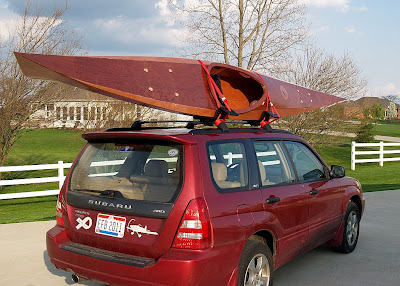


I gathered the troops and we made the 10 minute drive to the Big Darby. The boat is big and ungainly, and to be honest it's a royal pain to move around alone, so the extra help was a huge benefit. We got the boat into the water, and when it showed no immediate tendency towards plummeting to the bottom of the 8 inch deep water, I climbed in. This naturally lowered the boat enough that it was resting on the river bottom, so the trend towards failing to immediately sink was to continue for at least a few more gratifying moments. The entire operation had gained the undivided attention of all of the other folks hanging around the river banks by this time, so pride forced my hand: I pushed away from the sanctuary of the river bank and out into the open water:



Never having been in a kayak of any type before, I was surprised at how wobbly it is. It's a lot like the first time someone grabs the stick of the RV - they're surprised at how easily it rolls, and they often rock it back and forth trying to get it settled down. There's a benefit to that quick response in the RV, and it's quite likely that it's a good thing in the kayak as well. It's a very long boat, and as a result it's pretty hard to get it turned around. There may be some quicker way to turn it that depends on its ability to heel over as quickly as it does - I think I might have to see if I can find a Kayaking for Dummies book to get a better feel for how I'm supposed to drive this thing.
I was also very impressed at how easy it is to get it moving forward; very little effort with the paddle gets it going pretty fast:


Dinner had been delayed quite long enough by this time, so as much as I was enjoying paddling around in my pool toy, both the pit crew and I needed fed. I had mastered steering enough by this time to be able to hit the long, wide part of a river pretty accurately:

I'm just so proud of my little boat!

Update:
Regarding the "tippiness," I did a little research using the 'Peek Inside' feature on Amazon.com, whereby you can find out pretty much anything you want to know if you don't mind using the Surprise Me button until it finally hits the page you're looking for. As I suspected, the tippiness is used to make the boat easier to turn. The first few times I tried to turn the boat, it was liking pivoting an aircraft carrier. Essentially what was happening was that I was trying to push 17' of vertical surface against the resistance of the water. The proper thing to do is lean into the turn. That will change the shape of the hull that is felt by the water, or so said the book. By design, a cruising kayak like mine is somewhat resistant to turning when level since you don't want to ge fighting to keep it straight as you paddle; the tipping is used to make it turn when you want it to. Kind of like a motorcycle, I'm thinking.
The problem initially is that the tipping is oh so easy to do and you feel like it's just going to go all Poseidon Adventure you. It turns out, and I discovered this a little later by myself in my brief outing, that there is a thing called 'Secondary Stability'. This is when you've tipped the boat far enough that the big, flat chine is flat on the surface of the water. The tippiness more or less goes away at that point. It makes perfect sense, but it takes a few times trying it to convert it from a leap of faith into a proven fact. Next time out I'll try a few turns with a tip to the secondary stability position.
I'm still not sure what the value of doing this is, though:

Having kayaked some 2000+ miles, I would suggest that if your kayak is "tippy" that you use the knee braces more. Simple rule: "Lift the knee on the side you are paddling on". With very little practice, you should be able to balance paddling effort with knee lift and your boat should track with Ø tilt.
ReplyDeleteJust one suggestion...never kayak the coast of Maine, alone and in 30' swells. Rates a 9.9 on the sphincter scale for sure. 9 hours of searching for a harbor and constant paddling made a believer out of me.
You also may want to invest in a sea sock to make wet exits...less wet.
Congrats on the "first flight"!
ReplyDeleteI went to a kayak class once and damned neared drowned myself.
ReplyDeleteThe "flip over and right your self exercise" is a must to learn. You've got to be able to either (a) somersault out of that boat or (b) right it with the paddle if it capsizes. Being the tall person that I am, my knees got stuck trying to somersault out and I got stuck upside-down with the boat filling with water. I was just able to hold my face above the water and gurgle for help. Fortunately we were in a public pool and someone came and helped me up.
Man, that thing is really impressive looking.
ReplyDeleteI'm just so proud of my little boat!
ReplyDeleteAnd you should be proud, Dave. That's as fine a looking kayak as I've ever seen. MUCH better than those ubiquitous yellow fiberglas things one sees all over the place. Well done!
(And thanks for the link you gave me to these posts!)